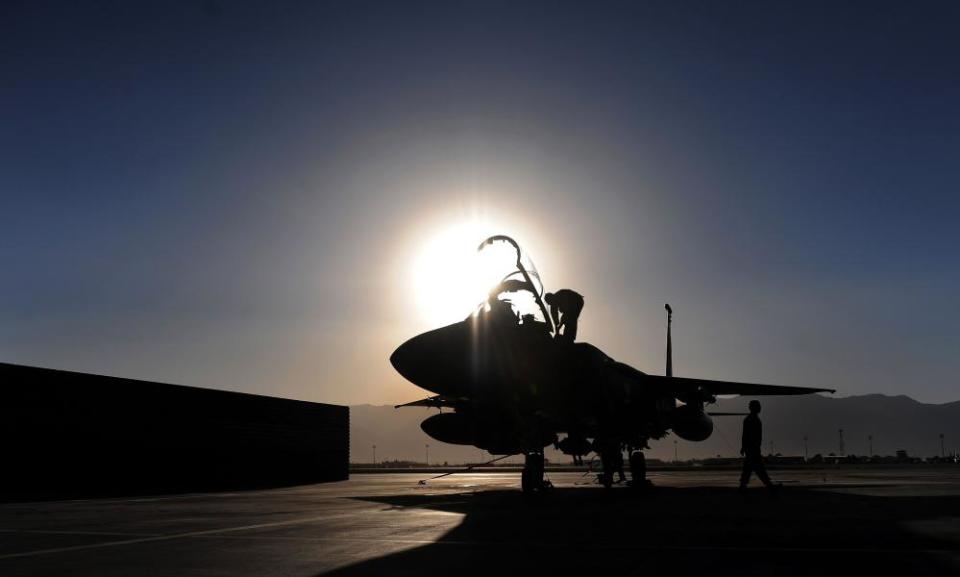US shoots down second Iran-made armed drone over Syria in 12 days
US says fighter shot drone as it approached outpost near borders of Syria, Iraq, and Jordan, the same day Russian jet came close to US warplane over Baltic Sea

US forces in southern Syria have shot down an Iranian-made armed drone in the second such incident in 12 days, in a further sign that Washington and Tehran’s agendas are colliding along the Syrian-Iraqi desert frontier.
A US F-15 fighter jet opened fire on the drone in the early afternoon because it was approaching a US outpost near al-Tanf where US advisors were training an anti-Isis local militia, according to the Pentagon spokesman, Capt Jeff Davis.
“The F15 intercepted the armed UAV [unmanned aerial vehicle] after it was observed advancing on coalition positions. It had ‘dirty wings’, meaning it was loaded with ordnance. The UAV did not make an attempt to divert,” Davis said.
Al-Tanf is a strategic point near the Syrian, Iraq and Jordanian borders. In a similar incident on 8 June, an Iranian-made drone of the same kind dropped a bomb near US troops at the same training outpost before it was shot down by a US plane.
“We have said before that demonstrated hostile intent and actions of pro-regime forces towards coalition partner forces in Syria that are conducting legitimate counter-Isis operations in Syria, will not be tolerated,” Davis said. “We do not seek conflict with any party in Syria other than Isis but we will not hesitate to defend ourselves or our partners if necessary.”
Russia accused the US-led coalition of “complicity with terrorism” by shooting down the drone. “In Syria this type of strike is akin to complicity with terrorism,” deputy foreign minister Sergei Ryabkov told the Interfax news agency.
And as Isis is dislodged from its current strongholds and outside powers compete for control of the vacated territory, the potential for clashes has escalated rapidly.
Tensions are also manifesting themselves in other arenas. On Tuesday, the US reported that a Russian fighter jet came within five feet of a US warplane over the Baltic Sea. US officials said the plane was armed and flying “erratically”. The incident is one of a long string of close encounters as Nato and Russian forces exercise in close proximity.
UN secretary general Antonio Guterres warned that the recent incidents could be “very dangerous” and lead to an escalation of the war in Syria.
“I strongly hope that there will be a de-escalation of the situation because these kinds of incidents can be very dangerous in a conflict situation in which there are so many actors and in which the situation is so complex on the ground,” said Guterres.
In Syria, Russia announced on Monday that it had suspended a military hotline with US forces and threatened to shoot down coalition planes that flew west of the Euphrates river after the US shot down a Syrian-piloted bomber that flew too close to a US-supported force advancing on the Isis bastion of Raqqa in northern Syria.
Just before the shooting down of the Syrian bomber, US officials say there was a movement of regime ground troops with tanks and artillery towards two towns near Raqqa that were held by US-backed Syrian Democratic Forces (SDF).
According to the Pentagon, US warplanes conducted a show of force to try to warn off the advance including strafing runs near regime lines.
At that point the Syrian government Su-22 approached and the US aircraft also tried to warn it off by firing flares and carrying out a “head butt manoeuvre”, which entails flying just in front of an aircraft so it is jostled by the wake of the jet engines.
According to the Pentagon account the Su-22 pilot ignored the warning and went into a dive to bomb SDF positions. After that the Syrian jet was shot down by the US warplanes.
The US military said there were no signs on Monday that the “deconfliction” channel had been suspended and that they were keen to defuse tensions. On Tuesday, Davis said: “We remain available on our end. I’ll leave it to the Russians to state their level of participation.”
The spokesman said that US air operations were continuing, including west of the Euphrates, with some changes to altitude and flight plans in order to “mitigate risk”. On a previous occasion in April when Moscow declared it was closing the deconfliction line as a response to a US missile attack on a Syrian regime air base, the channel was left open and continued to operate normally.
However, Australia announced it was suspending its flights as part of the coalition while there was uncertainty over the deconfliction channel. “As a precautionary measure, Australian defence force strike operations into Syria have temporarily ceased,” the Australian department of defence said on Tuesday.
Australia has six fighter jets based in the United Arab Emirates that strike targets in Syria and Iraq.
The Iranian drones shot down in the Syrian desert are of the time, Shahed-129, a relatively new addition to Iran’s substantial drone armoury. The Pentagon said it was not aware who was operating the drones shot down over the past two weeks but said that Iran has provided this drone type to the Syrian regime and to the Lebanese Shia militia, Hezbollah. But US officials said that units of Iran’s Islamic Revolutionary Guard Corps (IRGC) were known to be in the area.
Galen Wright, an expert on Iranian armaments who runs a blog on the subject, the Arkenzone, said that the Shahed-129 required a runway to take off and land. “Even if its Syrian, Iraqi or Lebanese personnel pushing the buttons, IRGC personnel or advisors are almost certainly nearby,” Wright said. “Especially given that Shahed-129s are still relatively rare.”

